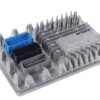Restore Peak Performance to Your GM Vehicle
Is your Escalade, Sierra, or Corvette suffering from frustrating issues like a persistent check engine light, poor engine performance, stalling, or a complete no-start condition? These are classic signs of a failing Engine Control Module (ECM), the critical brain of your vehicle. Don’t let a faulty computer keep you off the road. This professionally programmed Engine Control Module is the definitive solution to restore your vehicle’s power, reliability, and smooth operation.
Common Symptoms & Your Direct Solution
A failing ECM can cause a wide range of problems that can be difficult to diagnose. If you’re experiencing any of the following, this module is your answer:
- Persistent Check Engine Light (CEL)
- Diagnostic Trouble Codes (DTCs) related to module communication (e.g., U0100)
- Engine stalling, sputtering, or misfiring
- Failure to start or intermittent starting issues
- Noticeable decrease in fuel economy
- Erratic transmission shifting or performance
This isn’t just a replacement part; it’s a fully integrated solution. We use your vehicle’s unique Vehicle Identification Number (VIN) to flash this 2017 Escalade ESV Engine Control Module 12686382 with the latest, most stable software updates directly from GM. This ensures perfect compatibility and restores the precise performance your vehicle was designed to deliver.
Features & Benefits
- ✔ VIN-Programmed for Your Vehicle: Arrives ready for installation, flashed with the correct GM calibrations for your specific truck or SUV. This eliminates the need for an expensive trip to the dealership for programming.
- ✔ Restored Engine Performance: Resolves common drivability issues, restoring smooth idling, crisp acceleration, and optimal power delivery.
- ✔ Plug & Play Installation: Once the simple security relearn is performed, this module integrates seamlessly with your vehicle’s existing systems.
- ✔ Latest GM Software: Programmed with the most recent factory updates to improve performance, efficiency, and long-term reliability over older software versions.
- ✔ Cost-Effective Solution: A smart, reliable alternative to the high costs and scheduling hassles of a dealership repair.
- ✔ This unit is backed by our one-year replacement warranty.
Expert Insight: Why VIN Programming is Non-Negotiable
In modern GM vehicles, the ECM is the central hub for dozens of systems, from the engine and transmission to the anti-theft and emissions controls. Simply swapping a module from another vehicle, even an identical one, will result in a no-start condition. Each ECM is coded to its original vehicle’s VIN. Our professional programming service bridges this gap, tailoring the module’s software to your exact specifications. This ensures all systems communicate correctly, giving you a reliable repair and the peace of mind that the job was done right.
Take control of your repair and get your vehicle back on the road with confidence. By providing your VIN at checkout, you ensure that the 2017 Escalade ESV Engine Control Module 12686382 you receive is perfectly matched to your vehicle’s requirements, making for a straightforward and successful installation.
Frequently Asked Questions
What do I need to do after I place my order?
After you complete your purchase, you must send us your vehicle’s 17-digit VIN. We cannot program and ship your module without it. You can typically add this as a note during checkout or send it to us via email with your order number.
Will my vehicle start immediately after installation?
In many cases, yes. However, due to GM’s anti-theft systems, some vehicles will require a security relearn procedure if they do not start. This is a standard step that requires a compatible scan tool with GM software (like Tis2web/Techline Connect) and is the responsibility of the installer.
Are any other relearn procedures necessary?
Depending on your specific vehicle and the issues you were having, other system relearns like a crankshaft position variation relearn or injector flow rate programming may be required. These are standard procedures for any ECM replacement.
How do I know if this part number will fit my vehicle?
This module, part number 12686382, is a direct replacement for several other part numbers, including 12692068, 12704476, 12674052, and more. Please check the detailed fitment list on this page to confirm compatibility with your specific year, make, and model.
Where is my VIN located?
You can find your 17-digit VIN on the driver’s side of the dashboard (visible through the windshield), on the driver’s side door jamb sticker, or on your vehicle’s registration and insurance documents.


